
The Siuru literary movement, named after a fire-bird in Finnic mythology, was founded in 1917 in Estonia. [1] [2] It was an expressionistic and neo-romantic movement that ran counter to the Young Estonia formalist tradition.

The Siuru literary movement, named after a fire-bird in Finnic mythology, was founded in 1917 in Estonia. [1] [2] It was an expressionistic and neo-romantic movement that ran counter to the Young Estonia formalist tradition.
Along with the founder August Gailit, the movement included the following young poets and writers: Marie Under, Henrik Visnapuu, Johannes Semper, Friedebert Tuglas, Peet Aren, Otto Krusten, and Artur Adson. Between 1917 and 1919, Siuru published three volumes of poetry. 1919 led to conflicts within the group. Visnapuu and Gailit left, while Johannes Barbarus and August Alle joined as new members.
The members of Siuru had an affinity with futurism and Impressionism. Their poetry was often seen as scandalous due to their erotic nature. Siuru's philosophy stressed the freedom of the human spirit. Mottos of the group included Carpe diem!, and May the joy of creation be our only moving force, the latter suggested by Friedebert Tuglas. The group's symbol was white chrysanthemum.

A major result of Siuru's activities was popularisation of literature among Estonian people, leading to the active development of original Estonian literature in the young Republic of Estonia. While the movement itself was short-lived, cut short by Estonian independence and the ensuing movement of national literature, its members rose to be major figures in Estonian literature through Estonia's first period of independence and in the exile Estonian literary community during Soviet occupation.
Marie Under (1883–1980) was the leader of the movement, publishing her first book, Sonnets, in 1917. While her expressions of nature found a wide audience, her frank eroticism shocked conservatives, a motif she carried on in her subsequent works. Under went on to a long and distinguished literary career, publishing her last book in 1963. [2]
Artur Adson (1889–1977) published his first collection of poems, The Burning Soul, in 1917. Both this and his next collection, Old Lantern (1919), consisted of juvenile love poems. Adson went on to widely expand his genre, including dealing with social issues in a classical form. Adson wrote numerous plays. His Four Kings, a drama on the Estonian uprising of 1343, is considered his most thrilling work. He continued to write in exile, also publishing several books of memoirs, the last in 1953. Adson was Marie Under's second husband. [2]

Marie Under was an Estonian poet. She was nominated for the Nobel Prize in Literature in 14 separate years.
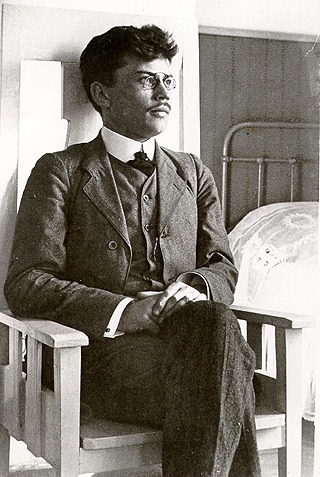
Friedebert Tuglas, born Friedebert Mihkelson or Michelson, was an Estonian writer and critic who introduced Impressionism and Symbolism to Estonian literature. Persecuted by the authorities in the beginning of 20th century, he later became an acknowledged representative of Estonian literature in the Soviet era.
Nationality words link to articles with information on the nation's poetry or literature.

Henrik Visnapuu was an Estonian poet and playwright.
Estonian literature is literature written in the Estonian language The domination of Estonia after the Northern Crusades, from the 13th century to 1918 by Germany, Sweden, and Russia resulted in few early written literary works in the Estonian language. The oldest records of written Estonian date from the 13th century. Originates Livoniae in Chronicle of Henry of Livonia contains Estonian place names, words and fragments of sentences. The Liber Census Daniae (1241) contains Estonian place and family names. The earliest extant samples of connected Estonian are the so-called Kullamaa prayers dating from 1524 and 1528. The first known printed book is a bilingual German-Estonian translation of the Lutheran catechism by S.Wanradt and J. Koell (1535). For the use of priests an Estonian grammar was printed in German in 1637. The New Testament was translated into southern Estonian in 1686. The two dialects were united by Anton Thor Helle in a form based on northern Estonian. Writings in Estonian became more significant in the 19th century during the Estophile Enlightenment Period (1750–1840).

Young Estonia was a neo-romantic literary group established around 1905 and led by the poet Gustav Suits and short story writer Friedebert Tuglas. Other members of the group included Villem Grünthal-Ridala and Johannes Aavik. Gustav Suits articulated the ideology of the group thus:
"What buoys up and exalts humanity is education. Our slogan is: More culture! More European culture! Let us remain Estonians, but let us become Europeans too. We want to discover the ideas and forms towards which we are impelled by our national spirit, character, and needs on the one hand, and by European culture on the other."

Artur Adson was an Estonian poet, writer and theatre critic.

August Alle was an Estonian writer.
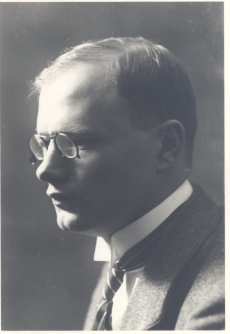
August Gailit was an Estonian writer.
Kersti Merilaas was an Estonian poet and translator. In addition, she wrote poems and prose for children and plays.

Toila is a small borough in Ida-Viru County, in northeastern Estonia. It is located about 10 km (6 mi) northeast of the town of Jõhvi, on the coast of Narva Bay. Toila is known as an important sea resort in Estonia, with a spa hotel, beach and a beautiful park. Toila is the administrative centre of Toila Parish. As of the 2011 Census, the settlement's population was 780, of whom the ethnic Estonians made up 628 (80.5%).
Looming is the oldest literary magazine in Estonia. The headquarters is in Tallinn.
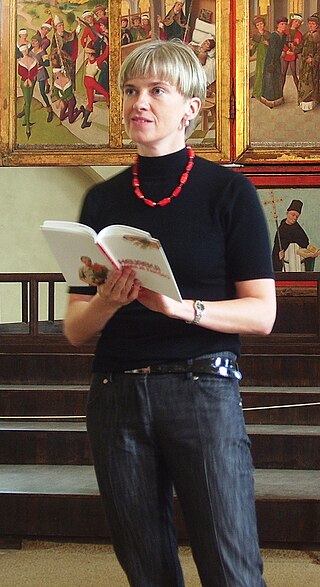
Maarja Kangro is an Estonian poet, short story writer, novelist, essayist, nonfiction writer and librettist.
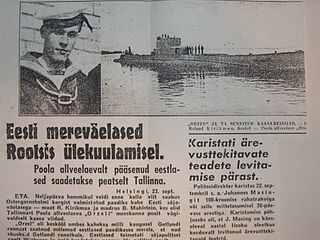
Uus Eesti was a daily newspaper published in Estonia from September 1935 until the Soviet occupation of Estonia in June 1940. The newspaper was politically aligned with the Estonian government.
100 great Estonians of the 20th century is a list of notable Estonians compiled in 1999 by Eesti Entsüklopeediakirjastus, Eesti Päevaleht, National Library of Estonia, Radio Kuku, and TV3.
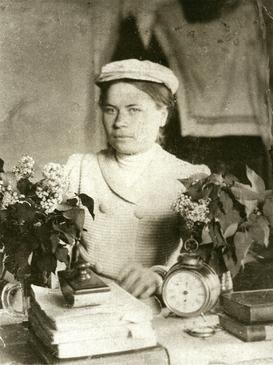
Marie Heiberg was an Estonian poet. When she was only about 15 years old she wrote her first poems which were acclaimed for their youthful freshness. Heiberg spent the last twenty years of her life in a mental institution. There is a memorial to her memory in Urvaste.

Eeva Park is an Estonian writer.

Eesti Kirjanike Kooperatiiv was a publishing house in Lund, Sweden.
Tarapita was an Estonian literature group which was active between 1921-1922.

Janika Kronberg is an Estonian literary scientist and critic.